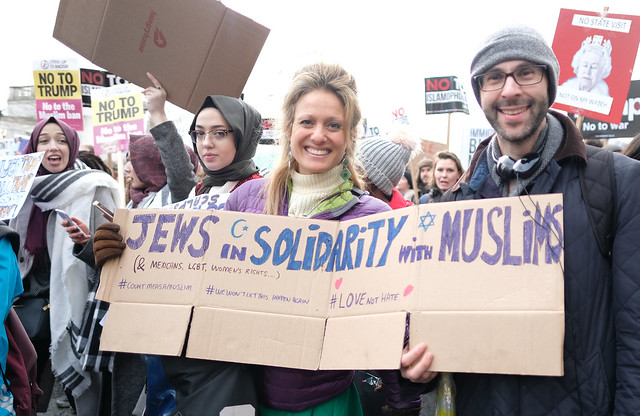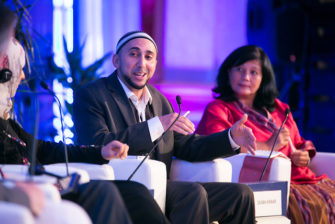
Religious communities, places of worship, cemeteries, wedding celebrations, and other sacred events and places have become targets for spectacular terrorist violence. It is hardly shocking news anymore. Most likely people will ask in the aftermath of a news story about killing in places of worship “how many?” rather than “why?” Such incidents are so routine that we no longer seek to understand them. Sacred spaces, times, and rituals (such as parades) have long been sites and occasions for communal violence and for generating exclusionary nationalist narratives and a broad spectrum of political violence. Stanley Tambiah, Michael Sells, and many other students of religion and violent nationalist discourses have noted the complex intersection of selective retrieval of religious traditions and the production and reproduction of chauvinistic accounts of peoplehood. Such retrievals have provided rationales for exclusion and xenophobia, as well as the delegitimization of the citizenship rights of supposedly non-normative citizens. Hence, for example, Hindutva nationalist discourse renders Muslims not really Indians. As Olivier Roy laments in a recent volume, the same pattern can be found in case after case where appeals to exclusionary citizenship build upon racialized and/or ethnicized interpretations of religion as belonging.
While targeting religious communities in moments of vulnerability and communal engagement raises profound questions pertaining to the relation between religion and violence, it should also force us to interrogate the responses of religious actors and communities to such violence. It has become almost as routine as the terrorist acts themselves for visible religious leadership to offer condemnation of such seemingly senseless acts of violence and declare that any invocation of religiosity in authorizing murderous acts of terrorism, in effect, represents a departure and perversion of authentic religious traditions. As historian Anthony Marx noted, the language of authenticity undergirded the political projects of modernity, which included the nation-state’s instrumentalization of cultural others for the purpose of consolidating and reproducing national coherence. It precludes openness for internal pluralities and reifies traditions by employing colonial taxonomies, standardization, and complex institutional reproductions of religions as features of “culture” and “national heritage” with fixed boundaries that must be policed. The latter coalesces with biologized and racialized conceptions of national or ethnic reproduction. Authenticity and (blood) purity constitute pivotal dimensions of modernity.
The performativity of interfaith vigils to express solidarity with the victims of terrorist actions that clearly target people gathered in their religious and communal spaces offers a profound expression of interfaith solidarity only if it disrupts the deep legacy of the construction of “faith” as an instrument of empire. The fact that, in addition to the Sri Lankan churches targeted on Easter Sunday 2019, luxury hotels designed to entertain foreigners were likewise targeted is telling of the symbolic association of Christianity with colonial violence and neoliberalism. Even if the churches in the previously colonized world have become indigenous over the centuries, the discourse of authenticity that indeed afflicts those who interpret their actions as anti-colonial renders such churches symbols of the colonial past and its presences. These colonial presences also manifest in the global neoliberal exploitative order. By fixing the meaning of Christianity as “foreign” and “violent” the discourse of authenticity renders Christianity, just as much as the sites of luxury hotels in the midst of poverty and marginalization, a symbol of colonization. Indeed, the modernist discourse of authenticity that has characterized the colonial enterprise and its fluctuating foci on classifying people, defining their boundaries, and identifying their “religions” or lack thereof, facilitated the process of converting, controlling, enslaving, and eliminating them since the fifteenth century. Now, in the neoliberal stage, integrating the global South and the previously colonized into the global economy through ensuring hospitable institutions and political leaderships also engenders simplistic and vague resistance through the targeting of Christian and neoliberal symbols.
The conflation of these symbols foregrounds the requirement to interrogate the roots of the contemporary violence in the enduring legacies of coloniality, nationalism, and the role of religion therein. This concept, which originated with Aníbal Quijano, recognizes the interrelation between “modernity” as a narrative of progress and the labor of slaves and the logic of displacement and extermination of indigenous communities. It is also a concept that shares elective affinities with the earlier narratives of conversion and totalizing Christian cosmology, which eventually morphed into a totalizing secularist temporality. Without a robust account of the Christian tradition’s complicity with the persistent legacies of coloniality, efforts for religious peacebuilding and interfaith performativity of solidarity are lacking. Indeed, Christian feminist postcolonial theologians have long recognized the necessity of linking decolonial and feminist theological work with an intersectional capacity for social and political solidarity. In the same way that culturalist explanatory frames (that attributes causality to culture/religion/civilizational identity) engage in abstraction and betray an underlying orientalist perspective when they interpret Muslim violence without attending to geopolitics, Christians engage in abstraction when they disown claims to their tradition by white nationalists who commit murderous actions. Instead, it is critical that scholars and religious actors examine the interlacing of religion and race in the construction of belonging and non-belonging in the “nation” and even more broadly “humanity.”

Indeed, scholars have long identified the complicity of the comparative study of religion (together with anthropology, sociology, and other social sciences) with the construction of the (Christian) modern West and its political projects. Critical accounts of the construction of “religion” and “modernity” require interrogating, therefore, the complicity and entanglements of such approaches with global patterns of racialization, slavery, genocides, and capitalist exploitation. Rather than reclaiming a supposed authentic account of one’s faith (itself a modernist construct), intercommunal and interfaith solidarity that moves beyond performance focuses its critique on the modernist buttressing of communities and the employment of religion in the ghettoization and patterns of domination these communities experience. Hence, grassroots interfaith solidarity refuses the modernist logic of domestication and ghettoization of religion precisely through recognition, emerging on the ground in the inner cities as well as at the margins of religious communities themselves. As Ginna Green from Bend the Arc said in an interview for NPR: “we are not safe unless we are together.” The commonality among the acts of terrorism against communities of faith, even when Christians themselves are targeted in Sri Lanka, is their respective relation to the entanglement of Christianity with colonialism, white nationalism, orientalism, and modernist patterns of racializing and nationalizing religion. Therefore, even if, under one scenario, acts of targeted violence are intended to embolden antagonism and enhance communal divides, the response to such violence cannot settle into the existing frameworks that perpetuate such violence. Activist Rami Nashashibi, head of the Inner-City Muslim Action Network on the south side of Chicago, lucidly dispelled the modernist ghettoization. “Both the physical and spiritual well-being of our communities,” he told the interviewer in the same NPR piece, “depend on how well we are connected to one another.” This means, he added, that “Our isolation, our disconnection from one another only makes us that much more vulnerable to the forces of evil.…To the forces of hatred and bigotry that either want to silence us, intimidate us or pit us against one another to carry out really insidious agendas.” This important insight informs his and other grassroots faith-based activists’ coalition and solidarity work with one another.
This work moves beyond the imperial performance of vigils designed to reassert “authenticity.” It requires a deep intersectional analysis of the interlocking matrices of power, and a recognition that overcoming the logic that such matrices are built on requires not only exposing oppression, but also imagining cohabitation and solidarity outside the logic of imperial and domesticated religion. It is the same very insight that has animated Jewish activists in the aftermath of Charlottesville in 2017. When white nationalists marched with Klan-like torches, chanting “Jews will not replace us” as part of a protest against the supposed erasure of an icon of the Confederacy, (some) American Jews resolved to enhance their commitment to co-resistance against white supremacy (also tackling the construction of Jews as white) by deepening their understanding of the complex relations between anti-black racism and antisemitism. Similarly, Muslim community organizing excelled and exceeded organizers’ fundraising goals to help American Jews repair vandalized graves in Jewish cemeteries. In a different context, but one that nevertheless contained similar dynamics, in 2018 a six-day Emergency Religious Delegation to Honduras—comprised of fifty faith and civil leaders from the U.S., Canada, Colombia, and Argentina—accompanied human rights protectors, witnessed state violence, and reported about it through their local and global channels. Likewise, faith-based actors have persistently spent time at the US-Mexico border, calling out the geopolitical violence at the heart of the despair of asylum seekers and refugees. These are just a few (prophetic) examples that illuminate pathways for religious agency and expressions of interreligious solidarity that also centralize critical engagement with the violent legacies of modernity. These are forms of intercommunal solidarity that move beyond merely expressing surprise and indignation at the supposed perversion of religion manifested in such spectacular terrorist acts like those that occurred in Christchurch, Colombo, and at The Tree of Life synagogue in Pittsburgh. Such expressions of indignation reflect little interrogation of religion’s complicity in global and local patterns of racialization, marginalization, and nationalist violence.

